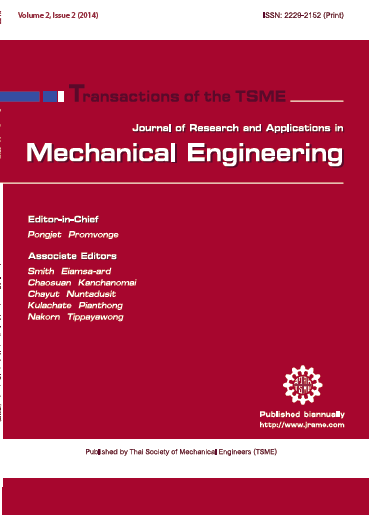Numerical heat transfer investigation in a tube with inclined flower baffles
Main Article Content
Abstract
A numerical investigation has been conducted to examine turbulent periodic flow and heat transfer behaviors in a three-dimensional isothermal-fluxed tube with flower baffle inserts. The computations based on the finite volume method were made by using the SIMPLE algorithm to handle the pressure-velocity coupling. The fluid flow and heat transfer characteristics are presented for Reynolds numbers ranging from 4000 to 20,000. All flower baffles are mounted periodically in the tube with a single inclination angle, = 30
. Effects of different pitch ratios, (PR = p/D) in the range of 0.75-2.0 with two flower leaf closure angles,
=25
and 35
on heat transfer and pressure loss in the tube are studied. It is apparent that counter-rotating vortex flows created by the flower baffles exist and help induce impinging flows on the tube wall leading to drastic increase in heat transfer rate over the smooth tube. In addition, the decrease in the PR results in the rise in the heat transfer and friction factor.
The computational results reveal that the optimum thermal performance for using the flower baffles is about 1.6 at PR = 0.75, = 25
.
Article Details
This work is licensed under a Creative Commons Attribution-NonCommercial-ShareAlike 4.0 International License.
References
[2] Guo, J.F., Xu, M.T. and Cheng, L. Numerical investigations of circular tube fitted with helical screw-tape inserts from the viewpoint of field synergy principle, Chemical Engineering and Processing: Process Intensification, Vol. 49, 2010, pp. 410-417.
[3] Zhang, X., Liu, Z.C. and Liu, W. Numerical studies on heat transfer and friction factor characteristics of a tube fitted with helical screw-tape without core-rod inserts, International Journal of Heat and Mass Transfer, Vol. 60, 2013, pp. 490-498.
[4] Promvonge, P., Sripattanapipat, S., Tamna, S., Kwankaomeng, S. and Thianpong, C. Numerical investigation of laminar heat transfer in a square channel with 45° inclined baffles, International Communication in Heat and Mass Transfer, Vol. 37 (2010), pp. 170-177.
[5] Promvonge, P. and Kwankaomeng, S. Periodic laminar flow and heat transfer in a channel with 45° staggered V-baffles, International Communication in Heat and Mass Transfer, Vol. 37, 2010, pp. 841-849.
[6] Promvonge, P., Sripattanapipat, S. and Kwankaomeng, S. Laminar periodic flow and heat transfer in square channel with 45° inline baffles on two opposite walls, International Journal of Thermal Science, Vol. 49, 2010, pp. 963-975.
[7] Promvonge, P., Jedsadaratanachai, W. and Kwankaomeng, S. Applied Thermal Engineering, Vol. 30, 2010, pp. 1292
[8] Promvonge, P., Changcharoen, W., Kwankaomeng, S. and Thianpong, C. Numerical heat transfer study of turbulent square-duct flow through inline V-shaped discrete ribs, International Communication in Heat and Mass Transfer, Vol. 38, 2011, pp. 1392-1399.
[9] Patankar, S.V. in: Numerical Heat Transfer and Fluid Flow, McGraw-Hill, 1980.
[10] Incropera, F.P., DeWitt, D.P., Bergman, T.L. and Lavine, A.S. in: Introduction to Heat Transfer, fifth ed., John Wiley & Sons Inc, 2006.



